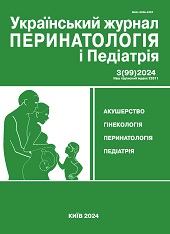Placenta accreta spectrum disorder management: literature review and authors experience
DOI:
https://doi.org/10.15574/PP.2024.3(99).124133Keywords:
placenta accreta spectrum disorders, massive obstetric hemorrhage, intensive care, fertility-preserving surgery, patient blood managementAbstract
Placenta accreta spectrum disorder (PSD) is a rare complication of pregnancy with extremely severe consequences, including hysterectomy, massive bleeding, and fetal asphyxia. The frequency of such disorders has been increasing over the past decades all over the world, which is primarily due to the higher frequency of cesarean sections and comorbidities, the older age of pregnant women. The experience of doctors worldwide in the treatment of patients with RSPA is limited and is limited to published descriptions of clinical cases or clinical case series.
The aim of this review is to analyze evidence-based medicine data on surgical treatment and intensive care approaches for patients with RSPA in the world, as well as to present our own experience of surgical treatment and intensive care for patients with placenta accreta (placenta increta).
According to the results of the literature review, the key points in the management of patients with RSPA are the strategies of adherence to Patient blood management: prevention and treatment of anemia in pregnant women, preparation of the blood bank for a possible massive hemotransfusion, adherence to protocols for the management of massive obstetric bleeding, in particular, the use of tranexamic acid and early hemotransfusion, objective calculation of blood loss, etc. The surgical technique of treatment is mainly hysterectomy with minimal blood loss (after suturing the incision on the uterus), however, in women who wish to preserve fertility, organ-sparing surgery using autohemotransfusion may be chosen in individual cases.
The research was carried out in accordance with the principles of the Declaration of Helsinki. The research protocol was approved by the Local Ethics Committee of the participating institution. The informed consent of the patient was obtained for conducting the studies.
No conflict of interests was declared by the authors.
References
Ahn SM, Jong HL. (2018, Mar). Perioperative Blood Management: Pros and Cons of ANH and Cell Salvagе. Hanyang Med Rev. 38(1): 27-37. https://doi.org/10.7599/hmr.2018.38.1.27
Eller AG, Porter TF, Soisson P, Silver RM. (2009). Optimal management strategies for placenta accreta. BJOG : an international journal of obstetrics and gynaecology. 116(5): 648-654. https://doi.org/10.1111/j.1471-0528.2008.02037.x
Fitzpatrick KE, Sellers S, Spark P, Kurinczuk JJ, Brocklehurst P, Knight M. (2012). Incidence and risk factors for placenta accreta/increta/percreta in the UK: a national case-control study. PloS one. 7(12): e52893. https://doi.org/10.1371/journal.pone.0052893
Grace Tan SE, Jobling TW, Wallace EM, McNeilage LJ, Manolitsas T, Hodges RJ. (2013). Surgical management of placenta accreta: a 10-year experience. Acta obstetricia et gynecologica Scandinavica. 92(4): 445-450. https://doi.org/10.1111/aogs.12075
Jauniaux E, Zheng W, Yan J. (2021). Confirming the Diagnosis and Classifying Placenta Accreta Spectrum (PAS) Disorders: Minutes of 2020 Online International Workshop on PAS in Beijing. Maternal Fetal Med. 3(4): 229-231. https://doi.org/10.1097/FM9.0000000000000106
Khong TY. (2008). The Pathology of placenta accreta, a worldwide epidemic. J Clin Pathology. 61(12): 1243-1246. https://doi.org/10.1136/jcp.2008.055202
Liu Y, Li X, Che X, Zhao G, Xu M. (2020, Aug 7). Intraoperative cell salvage for obstetrics: a prospective randomized controlled clinical trial. BMC Pregnancy Childbirth. 20(1): 452. PMID: 32767971; PMCID: PMC7412832. https://doi.org/10.1186/s12884-020-03138-w
Mogos MF, Salemi JL, Ashley M, Whiteman VE, Salihu HM. (2016). Recent trends in placenta accreta in the United States and its impact on maternal-fetal morbidity and healthcare-associated costs, 1998-2011. The journal of maternal-fetal & neonatal medicine : the official journal of the European Association of Perinatal Medicine, the Federation of Asia and Oceania Perinatal Societies, the International Society of Perinatal Obstetricians. 29(7): 1077-1082. https://doi.org/10.3109/14767058.2015.1034103
Piñas Carrillo A, Chandraharan E. (2019, Jan-Dec). Placenta accreta spectrum: Risk factors, diagnosis and management with special reference to the Triple P procedure. Womens Health (Lond). 15: 1745506519878081. PMID: 31578123; PMCID: PMC6777059. https://doi.org/10.1177/1745506519878081
Shepherd AM, Mahdy H. (2022, Sep 26). Placenta Accreta. In: StatPearls [Internet]. Treasure Island (FL): StatPearls Publishing; 2024 Jan. URL: https://www.ncbi.nlm.nih.gov/books/NBK563288. PMID: 33085435. Bookshelf ID: NBK563288.
Thurn L, Lindqvist PG, Jakobsson M, Colmorn LB, Klungsoyr K, Bjarnadóttir RI et al. (2016). Abnormally invasive placenta-prevalence, risk factors and antenatal suspicion: results from a large population-based pregnancy cohort study in the Nordic countries. BJOG : an international journal of obstetrics and gynaecology. 123(8): 1348-1355. https://doi.org/10.1111/1471-0528.13547
Zeng K, Huang W, Yu C, Wang R. (2018, Jun). How about "The effect of intraoperative cell salvage on allogeneic blood transfusion for patients with placenta accreta"?: An observational study. Medicine (Baltimore). 97(22): e10942. PMID: 29851834; PMCID: PMC6392750. https://doi.org/10.1097/MD.0000000000010942
Downloads
Published
Issue
Section
License
Copyright (c) 2024 Ukrainian Journal of Perinatology and Pediatrics

This work is licensed under a Creative Commons Attribution-NonCommercial 4.0 International License.
The policy of the Journal “Ukrainian Journal of Perinatology and Pediatrics” is compatible with the vast majority of funders' of open access and self-archiving policies. The journal provides immediate open access route being convinced that everyone – not only scientists - can benefit from research results, and publishes articles exclusively under open access distribution, with a Creative Commons Attribution-Noncommercial 4.0 international license(СС BY-NC).
Authors transfer the copyright to the Journal “MODERN PEDIATRICS. UKRAINE” when the manuscript is accepted for publication. Authors declare that this manuscript has not been published nor is under simultaneous consideration for publication elsewhere. After publication, the articles become freely available on-line to the public.
Readers have the right to use, distribute, and reproduce articles in any medium, provided the articles and the journal are properly cited.
The use of published materials for commercial purposes is strongly prohibited.

